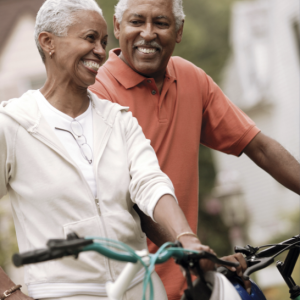Getting Around: Is It Time To Get Back On A Bike?

Getting Around: Is It Time To Get Back On A Bike?
May 19, 2021
Not to toot our own horn, but at agebuzz, we’ve been promoting the benefits of bike riding for older adults for some time now. Whether you’re just beginning or you’ve been cycling for decades, the physical and mental health benefits from cruising the open roads and trails are of tremendous value. We now have research showing that for older adults who want to walk more efficiently and achieve greater health benefits, interspersing an occasional bike ride into the mix will generate better results from your daily stroll. So strap on that bike helmet and read more here. And for anything and everything you might need to know about life as an older cycler, click here.
What’s perhaps the most exciting development in the world of cycling these days is the arrival of the “ebike,” bicycles that have a motor assist to give you the look and feel of a regular bike but with a motorized pedal-assist when you’re exhausted or climbing an incline. These bikes have really taken off since the pandemic took hold, and even though they can range in price from $1,000-$10,000, they’ve been hard for bike shops to keep in stock. For a comprehensive consideration of the latest ebike models to consider for older adults, with a comparison of everything from comfort to weight, to price and efficiency, slip on some spandex and look here.
If you’re just warming up to the idea of renewing your acquaintance with a two-wheeler, there are some safety tips you should consider. Bike riding is only as safe as the rider and unfortunately, fatalities among older cyclists have tripled in the last 4 decades. In fact, ebike riders, who tend to be over age 40, are more likely to be hospitalized or incur serious injuries than riders of conventional bikes. You can’t be too complacent or feel a false sense of security just because your bike has a motor. That being said, some basic tips as you begin include: riding with others, finding roads and paths with little or no traffic, honing your skills and instincts with a refresher course (for example, AARP has, in collaboration with the League of American Bicyclists, a free 32-page guide on smart cycling) and investing in good quality safety gear beyond your bike.
Regarding the gear, the key is to be visible to other cyclists, pedestrians, and drivers (50% of bike crashes occur at dusk or dark), so bright clothing, reflectors, and even lights during the day are a must. Regarding helmets, you’re best off with a helmet with the MIPS designation (Multidirectional Impact Protection System). Take a look here at Consumer Reports’ analysis of the best bike helmets out there. As experienced riders know, using a well-fitting helmet can decrease your chance of an injury by 50%. Other accessories that can not only enhance your safety but improve your comfort include proper hand grips, comfortable handlebars, a water bottle holder and perhaps riding gloves. For some suggested items to consider, adjust your mirrors and click here. Finally, if your butt’s uncomfortable then you’re unlikely to enjoy the ride. So click here for some soft suggestions to cushion your bottom as you hit the road.







